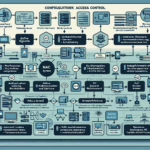Securing IT infrastructure for mobile devices is crucial, as these endpoints often serve as entry points for cyberattacks, especially in today’s remote and hybrid work environments. Below are steps you can take to secure your IT infrastructure for mobile devices:
1. Develop a Comprehensive Mobile Device Policy
- Bring Your Own Device (BYOD): Clearly define security requirements for employees who use personal devices for work.
- Device Enrollment: Require all devices (corporate and BYOD) to be enrolled in your Mobile Device Management (MDM) solution.
- Acceptable Use Policy: Specify permissible activities, apps, and configurations for devices accessing corporate resources.
2. Implement Mobile Device Management (MDM)
- Centralized Control: Use MDM or Enterprise Mobility Management (EMM) solutions to manage mobile devices, enforce policies, and monitor activity.
- Remote Wipe: Ensure you can remotely wipe corporate data from lost, stolen, or compromised devices.
- App Management: Restrict installation of unauthorized apps and enforce the use of corporate-approved apps for sensitive tasks.
3. Enforce Strong Authentication
- Multi-Factor Authentication (MFA): Require MFA for accessing corporate resources, such as email, VPN, or cloud services.
- Biometric Authentication: Leverage device-native authentication like fingerprint scanning or facial recognition.
- Password Policies: Enforce strong, complex passwords and periodic changes.
4. Encrypt Data
- Device Encryption: Mandate full-disk encryption for all mobile devices accessing corporate data.
- Data-in-Transit Encryption: Use VPNs or secure tunneling protocols like TLS to encrypt data transmitted between devices and corporate resources.
- Data-at-Rest Encryption: Ensure sensitive data stored on devices is encrypted.
5. Utilize Secure Applications
- Enterprise Apps: Provide corporate-approved apps for critical functions (e.g., email, file sharing, collaboration tools).
- Zero Trust Access: Implement application-level access controls based on user identity, device health, and network conditions.
- App Sandboxing: Use containerization to isolate corporate apps and data from personal apps on BYOD devices.
6. Monitor and Patch Mobile Device Vulnerabilities
- OS Updates: Enforce timely updates of operating systems to patch known vulnerabilities.
- App Updates: Ensure that corporate applications are regularly updated to include security fixes.
- Threat Detection: Integrate mobile threat defense (MTD) solutions to detect malware, phishing, and other threats targeting mobile devices.
7. Secure Network Access
- Wi-Fi Policies: Restrict access to corporate resources from unsecured public Wi-Fi networks.
- VPN: Require mobile devices to connect via a secure VPN when accessing corporate resources externally.
- Network Segmentation: Isolate mobile device traffic from critical IT infrastructure.
8. Restrict Device Features
- Camera and Microphone: Disable these features if not needed for work, especially for sensitive environments.
- USB Connections: Restrict access to external storage devices to prevent data leakage.
- Bluetooth: Disable or restrict Bluetooth use to avoid vulnerabilities like bluejacking and bluesnarfing.
9. Regular Audits and Compliance
- Device Inventory: Maintain an up-to-date inventory of all devices accessing corporate resources.
- Access Logs: Monitor logs for suspicious activity, unauthorized access, or unusual behavior.
- Compliance Regulations: Ensure mobile device policies align with relevant regulations (e.g., GDPR, HIPAA, PCI DSS).
10. Employee Training
- Security Awareness: Train employees on mobile device best practices, including identifying phishing attempts and avoiding risky behavior.
- Lost/Stolen Device Protocol: Educate employees on what to do if their device is lost or stolen.
11. AI and Automation
- AI-Driven Threat Detection: Use AI to analyze behavior patterns and detect anomalies or threats related to mobile devices.
- Automated Remediation: Implement automated responses to mobile security incidents, such as quarantining compromised devices.
12. Endpoint Security Integration
- Anti-Malware: Install endpoint protection solutions specifically designed for mobile devices.
- Zero Trust Framework: Enforce least-privilege access, ensuring devices only access the resources necessary for their role.
13. Backup and Recovery
- Cloud Backups: Regularly back up corporate data stored on mobile devices to secure cloud storage.
- Recovery Plans: Develop procedures for recovering data and functionality in the event of mobile-related incidents.
14. GPU Considerations
- If mobile devices use GPUs for AI or graphics-intensive applications, ensure GPU-based compute environments are secure. Restrict access to sensitive workloads and enforce encryption for GPU-based data processing.
15. Kubernetes Integration
- If mobile devices interact with Kubernetes clusters (e.g., for app development or monitoring), enforce RBAC (Role-Based Access Control) and restrict device access to Kubernetes APIs. Use tools like kube-bench to audit Kubernetes clusters for security compliance.
By implementing these measures, you can safeguard your IT infrastructure from vulnerabilities introduced by mobile devices while supporting productivity and flexibility.
How do I secure IT infrastructure for mobile devices?





